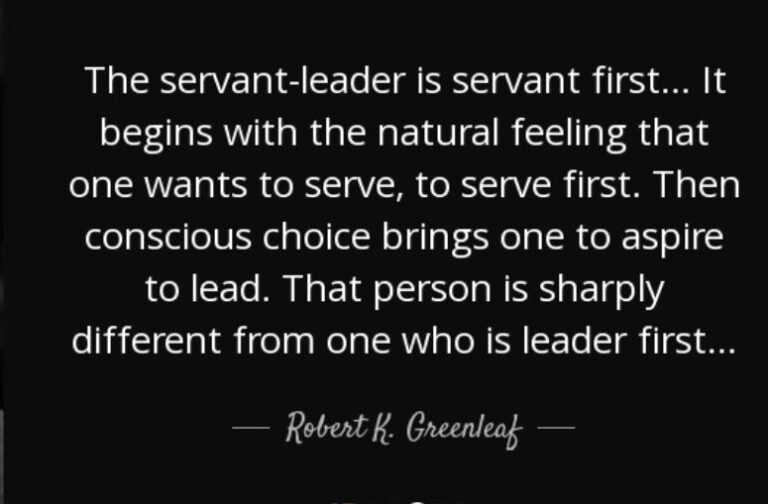One of the most common structures used in organizations over the ages is based on a hierarchical model of bosses and subordinates. It likely has its origin in military command-and-control units.
In this model today, every person reports to someone else, except the one at the top of the hierarchy who reports to a board. The organization chart looks something like this:
Hierarchies

This structure has lasted so long because it is well-known and efficient. Power and authority are vested in each of the bosses who have “subordinates” reporting to them. (The Latin roots of “subordinate” mean “placed in an inferior rank.”)
Power, Authority, and Ego
Robert Greenleaf understood this hierarchical necessity and said, “… in an imperfect world, authority backed up by power is still necessary because we just don’t know a better way.”
But Greenleaf also saw the darker side of this structure. He said, “The trouble with coercive power is that it only strengthens resistance. And, if successful, its controlling effect lasts only as long as the force is strong.” Author Edward Abbey said, “Power is always dangerous. Power attracts the worst and corrupts the best.”
All too often in the hierarchical organization, a boss with power lets their ego run amuck. Author Jonny Kim said, “Ego is probably one of the biggest poisons we can have—it’s toxic to any environment.” Robert Greenleaf said:
“Ego… micro-manages. It disempowers. It reduces our capability. It excels in control.… Ego focuses on one’s own survival, pleasure, and enhancement to the exclusion of others; ego is selfishly ambitious. It sees relationships in terms of threat or no threat. ”
We believe that ego-run-amuck is among the greatest threats to effective leadership.
Boss-First vs. Servant-First
Greenleaf saw a difference between a person who was a leader-first and one who was a servant-first. See Table 1 below for our depiction of how this works on a continuum, in this case from ”boss-first” to ”servant-first.”
Table 1. Boss-First vs. Servant-First
| Boss-First | Servant-First | |
| Personal Qualities | Always in charge, distant
Cynical, critical, a know-it-all Very busy, a taker, cuts corners Armor always up, uses power often Values: self, money, things, owners |
Leads & follows, in touch with people
Vulnerable, humble, a learner Takes sanctuary, giver, ethical/moral Approachable, uses power sparingly Values: people, all stakeholders |
| Communications | Talks first, tells, orders, directs | Listens first, asks, persuades, coaches |
| Decision-making* | “Steel,” the sole decider
Forces, uses own experience |
Uses “steel” & “velvet,” consensus
Helps, uses others’ experience too |
| Workplace Environment | Opaque, low-trust
Controlled, people feel limited People stressed, less healthy Fear abounds, silos, turfs Closed, few relationships People are means to boss’s ends Power resides only with boss |
Transparent, high-trust
Open, people feel free People less stressed, more healthy Positive culture, fluid structure Open, many relationships People are ends in themselves Many have empowered authority |
* “Steel” and “velvet” are terms we define in our book, Triple Crown Leadership.
It might be interesting to estimate where you are on this continuum. How about your boss, and your boss’s boss (if applicable)? Most people fall somewhere on the scale between the extremes.
Now, what are the results of these different leader types? What’s the effect on people and performance?
Boss-First Organizations Underperform
In the boss-first case, people are “subordinates” (“of inferior rank”) who are likely to comply with the boss’s directives only begrudgingly. They are closed-up, keeping their ideas, suggestions, experience, knowledge, and talents to themselves. They’re waiting for the boss to tell them what to do.
They have their heads down on their tasks only. They know they often work at cross purposes with others in the organization, but they are just following the boss’s orders, so it’s not their problem.
Their stress levels are high. They endure a harmful culture because they think “that’s the way the world is,” or because they need the job, or because they can’t see how to move on and start all over.
They feel trapped. They’re waiting every day for their workday to be over. They’re disengaged. At quitting time, the parking lots empty quickly. After work, they can get on to their real life.
Outside their job, many of them create, volunteer, and have impressive talents, skills, and avocations. They contribute to or lead nonprofits, programs, or causes.
Robert Greenleaf saw these skills and talents among the working men and women in the Midwest. He taught them in classes and learned how incredibly essential they were to AT&T.
This boss-first organization has:
- less innovation
- more problems that go unsolved
- higher turnover among employees and customers
- more defects
- longer cycle times
- more theft
- higher personnel costs
- lower revenue
- higher expenses

Personal Values Exercise
Complete this exercise to identify your personal values. It will help you develop self-awareness, including clarity about what’s most important to you in life and work, and serve as a safe harbor for you to return to when things are tough.
Servant-First Organizations Outperform
In the servant-first case, people are colleagues who are committed to the organization and each other. They’ve bought in at their jobs. And they’re self-inspired, open, and collaborative with their co-workers. They lead sometimes and follow at other times, as does their titular servant leader.
Servant-first leaders feel empowered and unleashed by an affirmative culture. They’re inspired by a shared purpose, their shared values, and their shared vision.
Servant-first leaders care for each other and cover for each other. With less stress, they’re mentally, physically, and emotionally more healthy. They have pride in their collective efforts. Also, they willingly and frequently take the initiative and offer their ideas and suggestions, seeing them considered and put into action when feasible. They’re aligned.
This organization has:
- more innovation
- newer products and services
- fewer unresolved problems
- a more stable workforce
- much happier customers
- quicker resolution of issues
- rapid-action teams with empowered leaders close to the issue at hand
- higher revenue
- lower costs
Toward Servant Leadership
In a speech to industry professionals back in 1935, Robert Greenleaf said:
“The master and servant relationship is going. We say now that no one should be made a supervisor to whom the workmen do not go for guidance and counsel before any designation of supervisory status is made. In a conference, it is not always possible to spot the boss. If he is wise, he knows how to drive hard with a light hand. His organization will work with zeal and inspiration and never be conscious of his direction. …
The old hard-boiled boss is rapidly becoming a thing of the past. This negative sort of supervision had as its criterion the discovery of weaknesses and limitations in people, a sort of pessimistic philosophy, for limitations are mighty easy to discover, and when in search of them, many fine qualities may be obscured . . .
A search for the capabilities and possibilities in people is gradually supplanting the search for their limitations. It is a more optimistic philosophy. But the basis for such a change in philosophy is far from sentimental, for it is the wise supervisor who realizes that the grist for his mill is contained in the possibilities in people and not in their limitations.” -Robert Greenleaf
Servant-leader organizations outperform the boss-led organizations.

Leadership Derailers Assessment
Take this assessment to identify what’s inhibiting your leadership effectiveness. It will help you develop self-awareness and identify ways to improve your leadership.
Tools for You
- Leadership Derailers Assessment to help you identify what’s inhibiting your leadership effectiveness
- Personal Values Exercise to help you determine and clarify what’s most important to you
- Alignment Scorecard to help you assess your organization’s level of alignment
More Articles from Our Series on Servant Leadership
- How to Become a Better Servant Leader
- The Essential Qualities of Servant Leadership
- Unleashing Leaders in Your Organization
- Who Determines If You’re a Leader?
- Do I Have to Be a Servant Before I Can Lead?
- Why Maximizing Shareholder Value Is Wrong
- How Robert Greenleaf Created Servant Leadership
- The Paradoxes of Servant Leadership
- Boards and Servant Leadership
Postscript: Quotations on Servant Leadership
- “Servant leadership is all about making the goals clear and then rolling your sleeves up and doing whatever it takes to help people win. In that situation, they don’t work for you; you work for them.” -Ken Blanchard
- “Servant leadership is a counterbalance to the glorification, deification, and lionization of leaders who have neglected or forgotten what they are there for. Greenleaf’s work is like a superego conscience prod to remind leaders of why they are there. It is so easy for organizations to get totally consumed with the bottom line, with financial stakeholders, and not with the workers, not with all the clawed cartography of people whose lives are affected by the organization.” -Warren Bennis
- “The first responsibility of a leader is to define reality. The last is to say thank you. In between, the leader is a servant.” -Max De Pree
- “The true price of leadership is the willingness to place the needs of others above your own. Great leaders truly care about those they are privileged to lead and understand that the true cost of the leadership privilege comes at the expense of self-interest.” -Simon Sinek
- “The rank of office is not what makes someone a leader. Leadership is the choice to serve others with or without any formal rank.” -Simon Sinek
- “True leaders understand that leadership is not about them but about those they serve. It is not about exalting themselves but about lifting others up.” -Sheri L. Dew
- “True leadership must be for the benefit of the followers, not to enrich the leader.” -John C. Maxwell
- “Ultimately, a leader is not judged so much by how well he or she leads, but by how well he or she serves.” -Kevin Cashman
++++++++++++
Bob Vanourek and Gregg Vanourek are leadership practitioners, teachers, trainers, and award-winning authors. They are co-authors of Triple Crown Leadership: Building Excellent, Ethical, and Enduring Organizations, a winner of the International Book Awards. Check out their Leadership Derailers Assessment, complete their Personal Values Exercise, or join their community and sign up for their newsletter. If you found value in this, please forward it to a friend. Every little bit helps!


